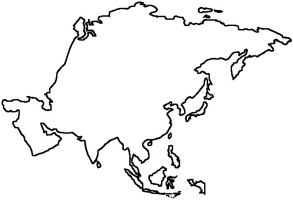
|
The Society of Folk Dance Historians (SFDH) Asia
[
Home |
About |
Encyclopedia | CLICK IMAGE TO ENLARGE |

|
BACKGROUND
Information: A region.
Asia is Earth's largest and most populous region, located primarily in the Eastern and Northern Hemispheres. It shares the continental landmass of Eurasia with the region of Europe and the continental landmass of Afro-Eurasia with both Europe and Africa. In general terms, Asia is bounded on the east by the Pacific Ocean, on the south by the Indian Ocean, and on the north by the Arctic Ocean. The border of Asia with Europe is a historical and cultural construct, as there is no clear physical and geographical separation between them. It is somewhat arbitrary and has moved since its first conception in classical antiquity. The division of Eurasia into two continents reflects East-West cultural, linguistic, and ethnic differences, some of which vary on a spectrum rather than with a sharp dividing line. The most commonly accepted boundaries place Asia to the east of the Suez Canal separating it from Africa; and to the east of the Turkish Straits, the Ural Mountains and Ural River, and to the south of the Caucasus Mountains and the Caspian and Black Seas, separating it from Europe.
Asia varies greatly across and within its regions with regard to ethnic groups, cultures, environments, economics, historical ties, and government systems. It also has a mix of many different climates ranging from the equatorial south via the hot desert in the Middle East, temperate areas in the east, and the continental centre to vast subarctic and polar areas in Siberia.
Languages: Asia is home to several language families and many language isolates. Most Asian countries have more than one language that is natively spoken. For instance, more than 600 languages are spoken in Indonesia, more than 800 languages spoken in India, and more than 100 are spoken in the Philippines. China has many languages and dialects in different provinces.
Religions: Many of the world's major religions have their origins in Asia, including the five most practiced in the world (excluding irreligion), which are Christianity, Islam, Hinduism, Chinese folk religion (classified as Confucianism and Taoism), and Buddhism respectively.
COUNTRIES, REGIONS, AND CULTURES
- Afghanistan, a country.
- Arabs, a culture.
- Armenia, a country.
- Azerbaijan, a country.
- Bahrain, a country.
- Bangladesh, a country.
- Bhutan, a country.
- Brunei, a country.
- Cambodia, a country.
- China, a country.
- Cyprus, a country.
- East Timor, a country.
- Egypt, a country.
- Georgia, a country.
- Hong Kong, a region.
- India, a country.
- Indonesia, a country.
- Iran, a country.
- Iraq, a country.
- Israel, a country.
- Japan, a country.
- Jews, a culture.
- Jordan, a country.
- Kazakhstan, a country.
- Kurds, a culture.
- Kuwait, a country.
- Kyrgystan, a country.
- Laos, a country.
- Lebanon, a country.
- Malaysia, a country.
- Maldives, a country.
- Middle East, a region.
- Mongolia, a country.
- Myanmar, a country.
- Nepal, a country.
- North Korea, a country.
- Oman, a country.
- Pakistan, a country.
- Persia, an empire.
- Philippines, a country.
- Quatar, a country.
- Russia, a country.
- Saudi Arabia, a country.
- Singapore, a region.
- South Korea, a country.
- Sri Lanka, a country.
- Syria, a country (and Assyria).
- Taiwan, a country.
- Tajikistan, a country.
- Turkey, a country.
- Turkmenistan, a country.
- United Arab Emirates, a country.
- Uzbekistan, a country.
- Vietnam, a country.
- Yemen, a country.
DOCUMENT
This page © 2018 by Ron Houston.
Please do not copy any part of this page without including this copyright notice.
Please do not copy small portions out of context.
Please do not copy large portions without permission from Ron Houston.